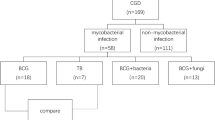Abstract
We report a case of tularemia presenting as a solitary pulmonary nodule following syngeneic PBSC transplant. Seven months after undergoing a syngeneic PBSC transplant for AML, our patient presented with fever without localizing signs. Chest X-ray revealed a solitary pulmonary nodule. Culture of a CT guided needle aspiration revealed Francisella tularensis. The patient was successfully treated with ciprofloxacin. His fever resolved and clearance of the nodule was documented on a CT scan 2 months after diagnosis and initiation of treatment. To our knowledge, this is the only reported case of tularemia occurring in the post-transplant setting. The possible relationship between transplant-induced immune dysfunction and the occurrence of this rare infection is discussed.
This is a preview of subscription content, access via your institution
Access options
Subscribe to this journal
Receive 12 print issues and online access
$259.00 per year
only $21.58 per issue
Buy this article
- Purchase on Springer Link
- Instant access to full article PDF
Prices may be subject to local taxes which are calculated during checkout
Similar content being viewed by others

Author information
Authors and Affiliations
Rights and permissions
About this article
Cite this article
Naughton, M., Brown, R., Adkins, D. et al. Tularemia – an unusual cause of a solitary pulmonary nodule in the post-transplant setting. Bone Marrow Transplant 24, 197–199 (1999). https://doi.org/10.1038/sj.bmt.1701863
Received:
Accepted:
Published:
Issue Date:
DOI: https://doi.org/10.1038/sj.bmt.1701863
Keywords
This article is cited by
-
Severe infections due to Francisella tularensis ssp. holarctica in solid organ transplant recipient: report of two cases and review of literature
BMC Infectious Diseases (2019)
-
Tularemia: an experience of 13 cases including a rare myocarditis in a referral center in Eastern Switzerland (Central Europe) and a review of the literature
Infection (2019)


